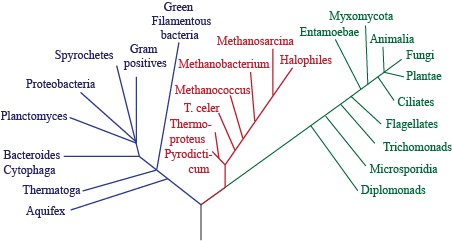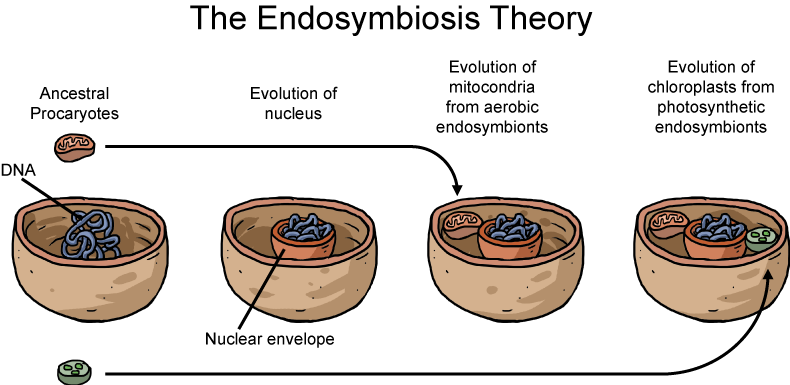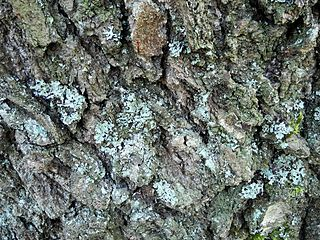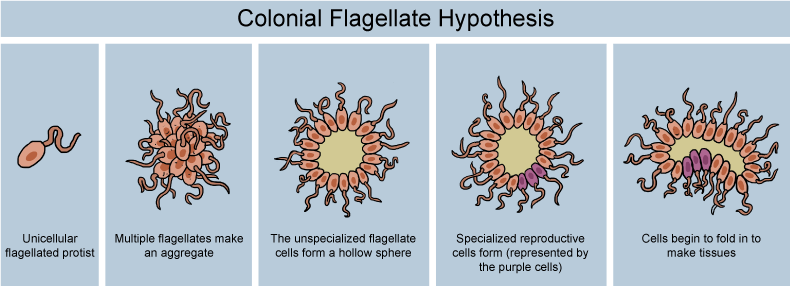Life Marches On
If you're like us at Shmoop, you don't consider sacs of self-replicating chemicals as "life." We at Shmoop also fire anyone who forgets to wear a Hawaiian shirt on Hawaiian Shirt Fridays (if you're reading this, Barry, no you cannot have your family pictures back). Life is so much more: the birds in the trees, the flowers in your garden, the mold growing on Frank's chili in the refrigerator. These are all what we consider life, even though we told Frank to throw away his chili weeks ago.
While prokaryotes and eukaryotes are very different from each other, archaea are like a hybrid between the two, a sort of prokaryote-eukaryote daywalker.

Three Domains of Life
Our self-replicating sac of chemicals acquired functions and diversified into one of three domains: prokaryotes, eukaryotes, and archaea. They grow up so fast…
You may want to sit down for this…did you know that all eukaryotic cells have prokaryotic cells LIVING IN THEM? Those prokaryotic cells are just happily cohabitating in the eukaryotic cell like some drifter who moved in to your apartment when you went on vacation to Hawaii.
The process of absorbing a prokaryotic cell into a eukaryotic cell is called endosymbiosis; two examples are mitochondria and chloroplasts.

Endosymbiosis
Mitochondria and chloroplasts exhibit many signs that they are products of endosymbiosis (endosymbionts). These include:
Despite this, some types of myxobacteria and other prokaryotes within a colony can have cells that differentiate, forming prokaryotic multicellular life.
There are two popular theories on the origins of multicellular life on Earth. They are:

Composite Lichens
Several types of protists, including ameobas and volvox, are examples that support the colonial theory. Unfortunately, these organisms do not form true multicellular organisms. Instead, they form organisms that have a few specialized cells, rather than the true separation of function that we see in multicellular organisms. Get lost amoebas, you're not multicellular either.
One organism the supports the colonial hypothesis is the Portuguese man o' war, a jelly-fish like organism which is actually a collection of many unicellular organisms called zooids. These unicellular organisms specialize to serve the various functions of the man o' war, and cannot survive on their own. See the evolution of multicellularity here.

Colonial Hypothesis
Domains of Life
In the late 18th century, a sad, lonely Swedish biologist named Carolus Linneaus took it upon himself to name and organize life on Earth. He developed a system of taxonomy, or classification of organisms, using the following hierarchy:- Kingdom
- Phylum
- Class
- Order
- Family
- Genus
- Species
- Homo sapiens (humans)
- Canis familiaris (dogs)
- Felis catus (cats)
- Drosophila melanogaster (fruit flies)
- Domain
- Kingdom
- Phylum
- Class
- Order
- Family
- Genus
- Species
- Star Trek fan
- Prokaryota
- Eukaryota
- Archaea
| Property | Prokaryotes | Eukaryotes | Archaea |
| Cell Wall? | Yes, composed of peptidoglycan | No, some have chitin wall | No, some have a pseudomurein wall |
| Genome Structure | Circular | Chromosomal | Circular |
| Gene Structure | Grouped in operons, no introns | Genes spread out, introns | Grouped in operons, no introns |
| Size | 1-10 μm | 100-1000 μm | 1-10 μm |
| Organelles | None | Yes | None |
| Ribosomes | 70S | 80S | 70S |

Three Domains of Life
Our self-replicating sac of chemicals acquired functions and diversified into one of three domains: prokaryotes, eukaryotes, and archaea. They grow up so fast…
Endosymbiosis
It'd be nice to imagine a world where the three domains exist in perfect harmony, none bothering any other. We'd really love to tell you that's how the story ends. We'd also love to tell you a great way to save money on car insurance. We just can't.You may want to sit down for this…did you know that all eukaryotic cells have prokaryotic cells LIVING IN THEM? Those prokaryotic cells are just happily cohabitating in the eukaryotic cell like some drifter who moved in to your apartment when you went on vacation to Hawaii.
The process of absorbing a prokaryotic cell into a eukaryotic cell is called endosymbiosis; two examples are mitochondria and chloroplasts.

Endosymbiosis
Mitochondria and chloroplasts exhibit many signs that they are products of endosymbiosis (endosymbionts). These include:
- Replication of mitochondria/chloroplasts occurs independently of eukaryotic cell replication (and is similar to prokaryotic replication).
- These organelles have double membranes, similar to prokaryotes.
- Both contain their own DNA that is similar to bacterial DNA and is circular.
- These organelles have their own ribosomes, similar to prokaryotic ribosomes.
- Protein synthesis begins with N-formylmethionine, just like in prokaryotes.
Multicellularity
We've gone from sacs of chemicals to a pretty good origin for all forms of single-cell (unicellular) life. What about plants, animals, and fungi—those wacky multicellular organisms? How did they get from single-cell life to multicellular life? Did they do it legally? For an organism to be considered multicellular, it has to have the following properties:- Cell-cell adhesion
- Intercellular communication
- Cell specialization
Despite this, some types of myxobacteria and other prokaryotes within a colony can have cells that differentiate, forming prokaryotic multicellular life.
There are two popular theories on the origins of multicellular life on Earth. They are:
- Symbiotic Theory: multiple different cells symbiotically grouped together to make a multicellular organism.
- Colonial Theory: colonies of one organism had individual cells specialize in function to make a multicellular organism.

Composite Lichens
Several types of protists, including ameobas and volvox, are examples that support the colonial theory. Unfortunately, these organisms do not form true multicellular organisms. Instead, they form organisms that have a few specialized cells, rather than the true separation of function that we see in multicellular organisms. Get lost amoebas, you're not multicellular either.
One organism the supports the colonial hypothesis is the Portuguese man o' war, a jelly-fish like organism which is actually a collection of many unicellular organisms called zooids. These unicellular organisms specialize to serve the various functions of the man o' war, and cannot survive on their own. See the evolution of multicellularity here.

Colonial Hypothesis